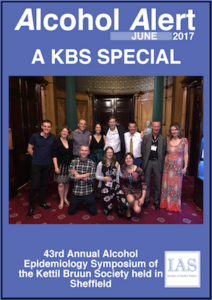In this month’s alert
Editorial – June 2017
Welcome to the June 2017 edition of Alcohol Alert, the Institute of Alcohol Studies newsletter, covering the latest updates on UK alcohol policy matters.
This month’s issue focuses on this year’s Alcohol Epidemiology Symposium of the Kettil Bruun Society, held in Sheffield. Other articles include: a review of Responsibility Deal finds alcohol industry calorie pledges short on content; Survey finds most departments do not routinely ask both age groups about their drinking habits; Canada votes to reintroduce an alcohol duty escalator; and new Welsh Government repeats pledge to introduce alcohol minimum pricing.
Please click on the article titles to read them. We hope you enjoy this edition.
TOP STORY: KBS – Researchers walk “advocacy tightrope”
Lunchtime session a highlight of week-long event (09 June)
 There is a real imbalance of power in the policy process, say expert researchers. The comments were made during a special lunchtime session titled ‘Walking the advocacy tightrope: What role can researchers play in the alcohol policy process?’, held at this year’s Kettil Bruun Society (KBS) symposium in Sheffield. Prominent researchers in the alcohol field spoke candidly about their experiences, hopes and concerns for researchers promoting their research in a politically charged environment, navigating the tensions between policymakers, NGOs, and industry.
There is a real imbalance of power in the policy process, say expert researchers. The comments were made during a special lunchtime session titled ‘Walking the advocacy tightrope: What role can researchers play in the alcohol policy process?’, held at this year’s Kettil Bruun Society (KBS) symposium in Sheffield. Prominent researchers in the alcohol field spoke candidly about their experiences, hopes and concerns for researchers promoting their research in a politically charged environment, navigating the tensions between policymakers, NGOs, and industry.
Dr Tim Stockwell, Director of the Centre for Addictions Research of BC (CARBC) in Victoria, Canada, urged researchers to be strategic in promoting their research; in his experience, commissioned studies have had the most direct impact on alcohol policy. He also stressed the importance of monitoring and surveillance data at a local level in order to “create a climate of opinion so that we have an appropriate level of concern” among decision-makers.
Representing the Centre for Alcohol Policy Research at LaTrobe University in Australia, Dr Michael Livingston spoke about his struggle to influence alcohol policy by building strong connections with policymakers in the face of attacks from industry. Michael believed that by working with expert alcohol advocacy groups, researchers could get more “bang for your buck”.
Dr Pia Mäkelä, Research Professor at the National Institute for Health and Welfare in Finland, recounted her experiences of being misunderstood by national media when explaining complex and ambiguous research findings against alcohol industry representatives who “know everything”. Pia saw accessibility as a fundamental aim of researchers’ output, championing the idea of promoting work in easy-to-use formats for general audiences.
Colin Angus, Research Fellow in the University of Sheffield’s Alcohol Research Group, spoke about the influence of the Sheffield Alcohol Policy Model (SAPM) in the alcohol pricing policy discourse since he joined the organisation. He highlighted the usefulness of working with advocacy groups to avoid misrepresentation of research.
 The 43rd annual KBS symposium, hosted by the Sheffield Alcohol Research Group (5–9 June), showcased ten-minute presentations on papers in progress from researchers across the globe on a variety of alcohol-related issues, including alcohol’s harm to children, directions in alcohol policy, alcohol policy and pricing. Tuesday’s breakout session ‘Behaviour change & drinking occasions’, featured Inge Kersbergen’s paper ‘Reducing the standard serving size of alcoholic beverages decreases alcohol consumption’ which won the early career researcher prize (see photo).
The 43rd annual KBS symposium, hosted by the Sheffield Alcohol Research Group (5–9 June), showcased ten-minute presentations on papers in progress from researchers across the globe on a variety of alcohol-related issues, including alcohol’s harm to children, directions in alcohol policy, alcohol policy and pricing. Tuesday’s breakout session ‘Behaviour change & drinking occasions’, featured Inge Kersbergen’s paper ‘Reducing the standard serving size of alcoholic beverages decreases alcohol consumption’ which won the early career researcher prize (see photo).
Next year’s symposium will be held in Thailand. Click on the Soundcloud icon to hear the Alcohol Alert podcast of the session ‘Walking the advocacy tightrope: What role can researchers play in the alcohol policy process?’.
Tower Hamlets Late Night Levy put on hold
Legal challenge from retail lobby group postpones council plans (01 June)
Tower Hamlets Council’s plan to charge pubs, clubs and restaurants for selling alcohol between midnight and 6am has been halted after a legal challenge.
The late-night levy, which was due to come into force on 1 June, was drawn up by the council in a bid to gather revenue to help combat drunken behaviour, which costs the authorities hundreds of thousands of pounds a year.
The average levy would vary on the size of the business in the borough, with the proposition stating that the council “must use the funds to tackle late-night alcohol-related crime and disorder”.
According to Tower Hamlets Council, there are 200 related ambulance calls in the borough; 22% of these happen at the weekends and 17% happen between midnight and 6am, the time of the proposed levy. The cost to the borough is estimated at £336,752 per year.
Mayor John Biggs said of the plans earlier this year: “We have a late-night problem around Spitalfields and Shoreditch that can only be dealt with by a borough-wide levy. We can’t selectively choose a geographical area.”
The Association of Licensed Multiple Retailers (ALMR) lodged a judicial review against the levy last month, claiming that it was unclear which establishments should be paying the levy.
ALMR chief executive Kate Nicholls said: “Tower Hamlets Council’s consultation on its late-night levy was flawed and denied businesses in the area a chance to engage knowing all the facts.”
“The ALMR will be scrutinising any further action by the council and will forcefully oppose any measures that heap additional costs on hardworking venues and threaten jobs and investment in eating and drinking out businesses.”
Responding to the verdict, the council announced that it would seek to rerun its consultation on the levy until August 23.
Drinking could raise brain damage risk
30-year study shows even moderate alcohol consumption can lead to impaired function (09 June)
A new study led by University of Oxford researchers has found that alcohol consumption, even at moderate levels, is associated with increased risk of adverse brain outcomes including hippocampal atrophy – a form of brain damage that affects memory and spatial navigation.
Published in the British Medical Journal, the experiment observed a random selection of 550 British men and women from the famous Whitehall II cohort study (mean age of 43 years at study baseline) who had their weekly alcohol intake and cognitive performance measured repeatedly over 30 years (1985–2015).
The participants – none of whom were considered alcohol dependent – were categorised according to the following alcohol consumption levels:
- ≥ 30 units a week (High consumption)
- 21–30 units a week (High consumption)
- 14–21 units a week (Moderate consumption)
- 7–14 units a week (Moderate consumption)
- 1–7 units a week (Light consumption)
- 0–1 units a week (Abstainers)
Cognitive function of participants was assessed at several points throughout the study through a variety of tests, including lexical and semantic fluency tests and short-term memory recall tests, to name a few. They also underwent an MRI brain scan at the end of the study (between 2012 and 2015).
Outcomes to look out for structurally included hippocampal atrophy, grey matter density, and corpus callosum (white matter) microstructure. Functional measures included cognitive decline over the stufy and cross sectional cognitive performance at the time of scanning.

Results
Potential confounding factors (i.e. factors which could have influenced the results) including age, sex, education, social class, physical and social activity, smoking, stroke risk, and medical history, were accounted for.
After adjusting for these, the study’s authors found that higher alcohol consumption over the 30-year period was associated with increased odds of hippocampal atrophy (ratio 5.8, 95% confidence interval (CI) 1.8 to 18.6; P≤0.001) compared with abstainers. The degeneration of the brain cells in the hippocampus area has crucial consequences for memory, spatial awareness and emotions, and is one of the areas that Alzheimer’s disease – the leading cause of dementia and memory loss – attacks first.
While those consuming over 30 units a week were at the highest risk compared with abstainers, even those drinking moderately (14-21 units per week) were three times more likely to have (right-sided) hippocampal atrophy compared with abstainers.
Higher consumption was also associated with poorer white matter integrity and faster decline in language fluency. The white matter microstructure facilitates communication between the two sides of the brain.
There was also no evidence to support light drinkers were relatively protected from either cognitive decline or hippocampal atrophy compared with abstainers – there was no protective effect of light drinking (up to 7 units per week) over abstinence.
No association was found with semantic fluency or word recall.
Interpretation
In the discussion section, the authors pointed out the study’s caveats. As an observational study, no firm conclusions can be drawn about cause and effect.
They also stated that the sample tested might not be representative of the UK population. “Most participants were educated and middle class men. The hippocampal atrophy associations we found in the total sample were replicated in men alone but not in women. This could reflect a lower power to detect an effect in women, in part because the sample was dominated by men (a reflection of the sex disparity in the civil service in the 1980s) and in part because few of the included women drank heavily”, they wrote.
“However, key strengths [of the study] include the information on long term alcohol consumption and the detailed available data on confounding factors.
“As such, our findings have important potential public health implications for a large sector of the population.”
So how to interpret the findings? Writing in a BMJ editorial on the study, Killian A Welch, consultant neuropsychiatrist and honorary senior lecturer remarked that the paper “certainly strengthens the view that if alcohol does confer beneficial effects on health, the link is probably confined to low intakes of no more than a unit a day.
“Even this level of consumption carries risk relative to abstinence for conditions such as breast cancer, and the evidence of benefit is certainly not strong enough to justify advising abstainers to drink.”
The authors also found that their findings supported the 2016 UK Chief Medical Officers’ weekly guidelines – which reduced the safe drinking limits for men from 21 to 14 units – while highlighting a potential issue with the United States guidelines, “which suggest that up to 24.5 units a week is safe for men… we found increased odds of hippocampal atrophy at just 14–21 units a week.”
“Alcohol might represent a modifiable risk factor for cognitive impairment, and primary prevention interventions targeted to later life could be too late”, they warned.
Dr Welch agreed with these findings, remarking that “with publication of this paper, justification of “moderate” drinking on the grounds of brain health becomes a little harder.”
Graphic cancer warnings on alcohol ‘could cut drinking’
Expert’s lessons from history send smoke signals to alcohol policy campaigners (09 June)
Graphic health warnings on the packaging for alcohol and junk food should be considered in future to highlight the dangers of cancer and obesity, one of the world’s leading public health experts has said.
Dr Judith Mackay, an advisor to the World Health Organisation (WHO), said there were lessons to be learned from the fight against smoking in efforts to “de-normalise” excessive alcohol or calorie consumption.
Dr Mackay told Herald Scotland that the WHO’s convention on tobacco control offered a potential template for similar international cooperation to reduce intakes of alcohol and unhealthy foods under the banner of cancer and diabetes prevention. In only a decade, the tobacco convention has driven widespread crackdown on advertising as well as the roll out of smoking bans, price and tax interventions, plain packaging and graphic health warning on cigarette packs.
Dr Mackay said: “About 100 out of nearly 200 signed up to the convention on tobacco have these graphic health warnings on the cigarette packs and many are getting plain packaging. Would the same happen to food labels and bottles of alcohol? It’s an interesting question.
“I think for alcohol… we know the harm – it’s not entirely inappropriate to put warnings on label not to drink in pregnancy for example, or not to give children alcohol – so there are some messages that countries could start with that would probably be accepted across the board, before food… for a long time with alcohol we have recognised that there is a problem with alcoholism, with with liver damage, with people becoming drunk. But what’s happened in the last decade is the realisation that there is a link between alcohol and cancer – to breast cancer, colorectal cancer, and oesophageal cancer, and some people are saying it is almost as harmful as tobacco in terms of causing cancer. That is an additional imperative to realise that we really need to do something about that.”
Currently professor of Public Health and Primary Care at the University of Hong Kong, Dr Mackay has spearheaded efforts to introduce tobacco control in countries including China, Mongolia, Vietnam and more recently North Korea, and that the same intervention which drove down tobacco consumption would also apply to alcohol, namely pricing.
Drawing on her experience, she said: “If I had to name to top five things to do about tobacco it would be price, price, price, price and price – it has the most fundamental effect, and I suspect it would too in alcohol. Minimum pricing, banning cheap alcohol in supermarkets – price, availability and tax, these are the issues that are going to bring the epidemic down.”
Messaging on women’s drinking “fatally flawed”
Dr Mackay, who addressed the SHAAP / IAS conference on ‘Women and Alcohol’ in Edinburgh, added efforts to reduce alcohol consumption in women were “fatally flawed” because they focused on pregnancy and binge drinking.
“The whole health messaging that women are ‘bad women’ if they don’t quit smoking or drinking for the sake of their foetus. I think that’s fundamentally flawed. The health messaging should be for women themselves. Otherwise, as soon as the pregnancy is over the women will tend to go back to their habits.
“The other focus is on ‘drunk young women’ . We see all these pictures of young women flat out on park benches, and the focus is on how disgusting they look, not how terribly harmful that is for their health. But in fact, an awful lot of drinking in this country is unseen: middle aged women drinking at home – half a bottle or a bottle of wine a day from the supermarket – which is often a very huge phenomenon.”
The next seminar in the ‘Women and Alcohol’ series will be held at the Royal College of Physicians in London on 15 September 2017, and chaired by Dr Sally Marlow, Public Engagement Fellow at Kings College London.
‘Sobriety tags’ scheme spreads
Two-year pilot will “help rehabilitate offenders” (12 June)
Offenders who commit crimes while under the influence of alcohol could be issued with so-called sobriety tags as part of a two-year trial.
The pilot, which uses ankle bracelets to detect alcohol levels in sweat, is being funded by Lincolnshire Police and Crime Commissioner (PCC) Marc Jones, who says the measures will help protect victims and rehabilitate offenders.
The Humberside, Lincolnshire & North Yorkshire Community Rehabilitation Company will be responsible for administering the pilot across all three police force areas. Its rollout follows the successful trial of a similar scheme in London where 92% of those tagged complied with the order.
The scheme aims to reduce alcohol-related crime by fitting binge drinkers who commit a defined set of alcohol-related crimes with Continuous Alcohol Monitoring tags that assess their sobriety, taking readings on a twice-hourly basis, on average. If the tag detects the presence of alcohol in the system, probation services are alerted and the individual concerned ultimately risks being sent back to court.
Offenders will be screened for selection; the scheme is not aimed at people who are alcohol dependent and who need specialist support. Those identified as unsuitable for the programme will be directed to treatment advice services.
According to the 2014/15 Crime Survey for England & Wales, there were 592,000 violent incidents where the victim believed the offender(s) to be under the influence of alcohol, accounting for 47% of violent offences committed that year.
Speaking about the scheme, Lincolnshire PCC Marc Jones said: “The pilot is really targeting those offences where violence and drink is a factor. Re-offending rates are much higher for people where alcohol plays a role in the offence, by tackling that we can reduce the likelihood of them re-offending.”
Alcohol labelling information, calorie-free
Industry pledge short on content (14 June)
The study ‘Provision of information to consumers about the calorie content of alcoholic drinks: did the Responsibility Deal pledge by alcohol retailers and producers increase the availability of calorie information?’ conducted by the London School of Hygiene & Tropical Medicine, highlights that the voluntary pledge by the UK industry in 2011 to provide information on alcohol calories has not led to any significant improvement in provision of this information to consumers. It found that calorie information only appeared on the labels of around 1% of 156 products examined, was not present in any of the supermarket branches visited in the study, and not routinely provided on supermarkets’ websites.
Alcohol is a major source of ‘hidden’ calories and a significant contributor to obesity. Among adults who drink, it is estimated that about 8% of their daily calorie intake comes from alcohol. However, no country in the world currently requires the calorie content of alcohol to be stated on packaging.
A recent European Commission report on the mandatory labelling of alcoholic beverages suggested that industry appears to be increasingly willing to adopt voluntary initiatives to offer nutritional information, citing commitments by some alcohol producers. In 2011, alcohol retailers and producers in England pledged to provide consumers with information on the calorie content of alcoholic drinks as part of the Public Health Responsibility Deal (RD).
One of the core commitments made by participating organisations was to ‘foster a culture of responsible drinking, which will help people to drink within guidelines’. Upon signing up to the RD, organisations were asked to provide pledge delivery plans, setting out how they would deliver on each pledge they had selected, and to send annual progress reports to the Department of Health. This study sheds light on how and to what extent such pledges have been implemented.
The research team found 70% of signatories to the pledges made no clear commitment to provide information or made no mention of calorie labeling in their pledge delivery plans. Progress reports were only available for a minority of signatories in 2012 and 2013. Most signatories (86%) provided progress reports in 2014, but the majority (74%) did not mention alcohol calories. Those that did had not provided information directly to consumers, or only in a very limited fashion.
Researchers assessed the extent of calorie information provided in the alcohol sections of the stores. The sample included five city-based stores from each of the 10 leading supermarkets and one major wine retailer, all of which had pledged to provide calorie information.
They also examined the online shopping websites (where available) of each supermarket to see what calorie information was provided on three specific alcohol products – white wine, beer, and vodka. The team also searched elsewhere on the supermarket websites and on their Facebook pages for information on alcohol calories. No information was provided in any of the stores and calorie information was not routinely provided on supermarkets’ websites.
The investigators conclude that one of the stated purposes of the RD to provide consumers with the information to make informed health-related choices did not take place to any significant extent.
Professor Mark Petticrew, from the Policy Innovation Research Unit at the London School of Hygiene & Tropical Medicine who led the study, said: “Alcohol contributes significant calories to the diet of even moderate drinkers, and provision of calorie information to consumers is a potentially important way of helping them reduce their calorie intake if they so wish. Few of the organisations that committed to act on this issue as part of the RD had taken specific action to provide consumers with alcohol calorie information in either their physical or online stores.
“The public is in favour of alcohol calorie labelling – lack of provision of information on alcohol calories makes it more difficult for people to make informed choices about their own health. Provision of alcohol calorie information would potentially contribute to measures to address the problem of adult obesity. The voluntary implementation of alcohol calorie labelling by industry needs to continue to be carefully monitored to determine whether and how it is done.”
The authors acknowledge limitations of the study, including that the findings may not apply to all stores across England. However, given the lack of provision of information in all the stores visited, it is unlikely that this is an artefact of the sample. It is more likely that it reflects a wider absence of information.
This article was first published on the London School of Hygiene & Tropical Medicine website. The research was funded by the Policy Research Programme of the Department of Health for England via its core support for the Policy Research Unit in Policy Innovation Research.
Don’t get too chill about alcoholic ice lollies, police warn
Desserts comparable in volume strength to a mid-strength lager (14 June)
Police have issued a drink driving warning over alcoholic ice lollies for the summer, as temperatures hit record highs.
Traffic officers from the Durham Constabulary released a statement reminding drivers who are “too chilled” about a new range of gin and tonic ice lollies that they could “land themselves in hot water”.
The lollies have become more popular as the British weather hots up, but each has an alcohol content of around 4.5%, similar to that of a mid-strength lager. Therefore, police officers insist that drivers need to make sure they stick to the legal limits like they would with alcoholic drinks.
“These lollies are becoming really popular and it’s easy to forget that they contain alcohol and aren’t just flavouring”, warned Acting Inspector Harry Simpson from the Cleveland and Durham Operations Unit. “On a hot summer’s day it is easy to lose count of how many you have and then get behind the wheel of a car.”
“If you wouldn’t consider drinking a gin and tonic or cocktail when driving, then you shouldn’t consider having one of these lollies. We always recommend that drivers refrain from any alcohol as the effects differ depending on age, weight and metabolism, and to check packaging to understand if there is any alcohol in what they are eating or drinking.”
Sexualised drinks ads undermine anti-rape campaigns
Researchers call for stricter licensing to counter hypersexual marketing practices (19 June)
Sexualised drinks advertising compromises the ability to counter sexual offending with anti-rape initiatives, claim academics from the University of Leicester.
‘Location, libation and leisure: An examination of the use of licensed venues to help challenge sexual violence’, was published in Crime, Media, Culture: An International Journal. Conducted by Dr Clare Gunby from the university’s Department of Criminology, Anna Carline from Leicester Law School and Stuart Taylor of Liverpool John Moores University, the paper looked into the effectiveness of anti-rape campaign messages in bars and clubs.
The researchers analysed focus group discussions of 41 male students aged 18–24, regarding a rape prevention campaign in Liverpool that directed its advice at males. They found that sexualised advertising undermined the call to end gendered violence.
The campaign used in the study was designed by Liverpool City Council in conjunction with the article authors and consisted of posters placed in male toilets and beer mats displayed in multiple youth-focused city centre bars and clubs, as well as across the city’s universities’ Student Unions for a period of three months. Posters included the strap-line ‘Can’t answer? Can’t consent – sex without consent is rape’ while the tagline on the beer mats stated ‘sex without consent is a crime’. Campaign materials were also hosted on the websites of partner agencies, in addition to a Facebook page and newspaper and radio adverts reiterating the messages of the campaign.
The researchers found that although participants reacted well to the simple campaign message during the discussions, the impact of these materials being placed in bars and nightclubs may have been hindered by the consequence of alcohol and rendered invisible against the sexualised images and entertainment that comprise nightlife.
Dr Gunby said: “Participants’ desire to have fun on nights out and to make determined efforts to disengage and ‘escape’ from the limits of the everyday could explain why so few participants were aware of the campaign – despite it being widely promoted.
“However, the most compelling explanation for their failure to notice the campaign was its perceived invisibility against sexualised drinks advertising and more explicitly violent advertising that links alcohol and intoxication with sexual offending. The latter form of advertising, we argue, undermines any competing rape prevention message.
“We would therefore like to see such advertising regulated to enable rape prevention work to be more visible, as well as to counter the role it plays in normalising sexual violence and recommend the development of a further Mandatory Licensing Condition that explicitly prohibits venue marketing from promoting or alluding to sexual violence.”
Stuart Taylor, from Liverpool John Moores University’s Law School, said: “There is a need to actively challenge practices employed by the alcohol industry which promote damaging behaviour as normative and acceptable – unless the harms associated with such activities are acknowledged and addressed, the night-time economy will continue to be a site of disproportionate victimisation for young people.”
Young and old missing out on A&E alcohol screening practices
Most departments do not routinely ask both age groups about their drinking habits (19 June)
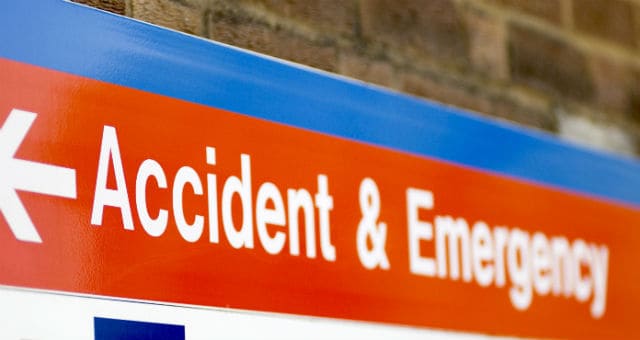 Nearly nine-out-of-ten Accident and Emergency (A&E) departments are failing to identify young people with alcohol problems, preventing them from getting the vital help they need, a new study in the Emergency Medical Journal has found.
Nearly nine-out-of-ten Accident and Emergency (A&E) departments are failing to identify young people with alcohol problems, preventing them from getting the vital help they need, a new study in the Emergency Medical Journal has found.
Conducted by researchers from the University of Surrey, the national survey of A&E departments discovered that neither young people nor those aged over 65 years are routinely asked about their drinking habits, a useful tool in detecting alcohol problems.
The survey gathered 147 responses from a total of 180 departments across England. A&E departments were found to be improving alcohol screening for adult patients in general, with over three-fifths routinely asking (63.6%) and using formal screening tools (61.4%) to detect alcohol consumption. More than 80% of departments had increased their access to alcohol health workers / clinical nurse specialists since 2011, offering expert advice and support to patients with alcohol problems. A&E departments were also reported to have had made progress in informing general practitioners of when individuals were admitted to hospitals, helping to create a care plan for the individual.
The majority of departments asked their child patients aged 11 – 17 years about their consumption (83.8%), but only 11.6% did so as a part of routine practice. This contravenes the NICE guidelines, which suggest that screening following by feedback of the results is the most effective way to reduce alcohol-related harm.
Lead author of the report Dr Robert Patton from the University of Surrey said: “Ending up in A&E is often a wakeup call for people and forces them to assess their alcohol consumption. However this is not always the case and sometimes involvement from a health care professional is what is required to support people in reducing their alcohol consumption.
“The fact that young people and those over 65 are not routinely asked about their alcohol intake results in their problem being swept under the carpet which is dangerous. Alcohol can destroy lives and puts undue pressure on the NHS, so it is important that the support is in place to help those affected.”
Rise in number of older drink-drivers
More pensioners caught because they “think they can still drive safely”, AA warns (20 June)
More elderly people are getting caught for drink driving because they believe they can still drive safely when drunk.
New figures suggest that pensioners are still getting behind the wheel after a drink – while teenagers are less likely to risk it. The number of under-19s caught drunk at the wheel has plummeted over ten years while the number of over-65s has risen.
Data released by the Ministry of Justice following a Freedom of Information request shows that 1,436 under-19s were caught drink driving in 2015, compared to 6,744 in 2005. The overall number of people convicted of drink driving has fallen from 84,540 in 2005 to 45,970 in 2015. But pensioners have bucked the trend, with the number of over-65s convicted of the offence rising from 1,295 in 2005 to 1,435 in 2015. However, just three over-65s have been convicted of causing death by careless driving while drunk or under the influence of drugs in the past ten years.
Accidents involving drivers who had been drinking also fell over the same period, from 10,080 in 2005 to 5,740, according to separate figures from the Department for Transport, with the number of fatal accidents falling from 470 to 180 (2015 figures are provisional at this point in time).
Expensive alcohol means young people are less likely to be driving home drunk from bars and clubs, according to a spokesman for the AA, who added that older drivers have a misguided view that they can still drive well after having had a drink.
He said: “For the younger drivers, the cost of alcohol in pubs and nightspots will have put downward pressure on drink-drive statistics in their age group.
“However, there is a need for targeted policing of places with late-night drinking.
“Although the majority will heed the warnings, it is the minority who flout the law and still pose a high risk. They are called the hard core – a cross-over group that includes elderly drink-drivers and others from all age groups.
“Hard core older drink-drivers will have developed bad habits over years, probably got away with it in the past and believe they can still drive safely when half-cut.”
He added that the figures suggested that “morning-after” enforcement designed to catch drinkers going to work still drunk was not working.
“What is surprising is that, with more of the enforcement done the morning after to catch the home boozers, the number of elderly drivers caught has gone up. With less likelihood of retirees needing to get up early to go to work, the chances of getting caught at that time of day must be lower,” he speculated.
This article was first published in The Telegraph.
Alcohol sales in England and Wales 50% above guideline levels
Minimum unit pricing seen as a solution to excess levels of drinking (21 June)
New figures published reveal that enough alcohol is being sold in England and Wales for every drinker to consume 21 units of alcohol every week – far more than the low-risk level of 14 units per week for both men and women recommended by the UK’s chief medical officers.
The situation is even worse in Scotland, with enough alcohol being sold for every drinker to consume 24 units a week. The data was compiled and released by NHS Health Scotland in ‘Monitoring and Evaluating Scotland’s Alcohol Strategy: Monitoring Report 2017’, its annual assessment of the nation’s relationship with alcohol, which brings together data on alcohol retail sales, price affordability, self-reported alcohol consumption and alcohol-related deaths, hospital admissions and social harms.
The report found that the Scots suffered worse harms compared with drinkers in England and Wales. In 2015, 22 people on average died in Scotland for alcohol-related reasons. This is 54% higher than in England and Wales. In the most deprived areas of Scotland, rates of alcohol-related death were six times higher than in the least deprived areas, while rates of alcohol-related hospital stays were nine times higher.
In 2016, 10.5 litres of pure alcohol were sold per adult in Scotland, equivalent to 20.2 units per adult per week, compared with 17.3 units per week in England and Wales. Given that the UK low-risk alcohol guidelines advise against men and women drinking above 14 units a week on a regular basis, this means that enough alcohol was sold last year in Scotland for every adult to exceed the guideline amount by 44%, every week of the year. Weekly sales of alcohol per adult are 17% higher in Scotland than in England and Wales, although the rate, which had increased between 2013 and 2015, returned to a similar level as in 2013.
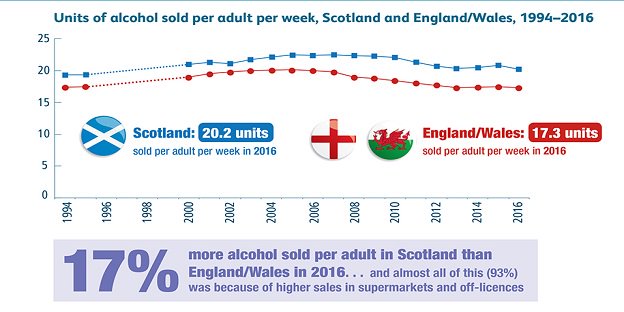
The lead author of the report Lucie Giles, Public Health Intelligence Adviser, said: “It is worrying that as a nation we buy enough alcohol for every person in Scotland to exceed the weekly drinking guideline substantially. This has harmful consequences for individuals, their family and friends as well as wider society and the economy. The harm that alcohol causes to our health is not distributed equally; the harmful effects are felt most by those living in the most disadvantaged areas in Scotland.
“Alcohol has becomes more affordable in recent years as disposable income has increased. In Scotland, more than half of all alcohol sold through supermarkets and off-licences is sold at less than 50 pence per unit.”
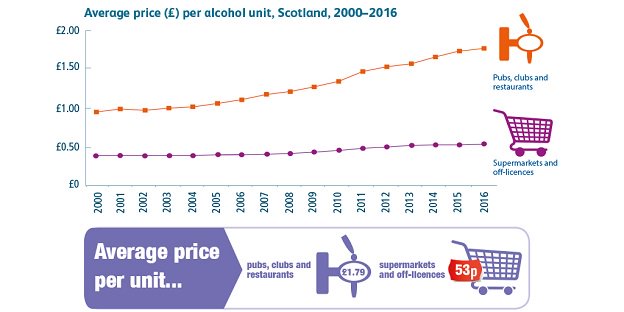
Although Scotland continues to have a problem with alcohol, the NHS Health Scotland team also acknowledged a number of encouraging findings. For example, the increase in population consumption in Scotland between 2013 and 2015 did not continue, with sales per adult returning to a similar level as in 2013. In addition, self-reported consumption data show that the proportion of people drinking at harmful levels has fallen and the proportion of non-drinkers has risen.
Alison Douglas, chief executive of Alcohol Focus Scotland, said: “It’s clear we need further action to change Scotland’s relationship with alcohol. One million Scots are regularly drinking too much; putting themselves at increased risk of liver disease, cancer, stroke and mental health problems.”
“It is important that we continue to monitor alcohol price, consumption and alcohol-related harms to inform and evaluate policy,” Lucie added.
Figures show why “minimum unit pricing is needed”
To tackle such high levels of alcohol-related deaths and illness, Scotland is set to introduce a minimum unit price for alcohol, which would raise the price of the cheapest alcohol products which do the most harm. The Scottish government passed minimum unit pricing over five years ago, though implementation of the measure has so far been delayed due to legal challenges from the alcohol industry.
Minimum unit pricing formed part of the Westminster government’s alcohol strategy in 2012, though has yet to be implemented in England and Wales.
Responding to the figures, Professor Sir Ian Gilmore, chair of the Alcohol Health Alliance UK (AHA), said:
“These figures are shocking and show why minimum unit pricing is needed in Scotland, as well as in the rest of the UK.
“As a result of the legal challenges from the alcohol industry, lives will undoubtedly have been lost in Scotland. We hope and expect minimum unit pricing to be ruled legal in the final court hearing in this case in July, so that implementation in Scotland can follow.
“If minimum unit pricing is ruled legal in Scotland, a decision by Westminster to delay would be a death sentence for some, including many from the lowest income groups. The evidence is already clear – minimum unit pricing saves lives, prevents illness and lowers hospital admissions.”
This article has been adapted from the Alcohol Health Alliance website.
Canada votes for alcohol tax rise
First move of its kind since the 1980s (23 June)
Prime Minister Justin Trudeau has followed his father’s footsteps in becoming the first Canadian political leader to introduce a federal tax increase on alcohol in three decades.
The new duty escalator will add a penny on to the price for a litre of wine, 7¢ to a 750-millilitre bottle of spirits and 5¢ to a 24-case of beer.
The measure temporarily formed a contested part of a federal budget bill that eventually passed as intended by both Houses of Parliament. The budget was held up by an amendment that would have removed the provision to tie annual increases in the alcohol excise duty to inflation.
The amendment – introduced by Conservative Newfoundland Senator Elizabeth Marshall – initially accepted the government’s proposal for a 2% increase to the duty applied to the cost of wine, beer and spirits while rejecting plans to tie the tax to the rate of inflation in future years. This measure was supported by several other senators from other parties who wanted to retain their right to review tax increases.
One such Senator, Saskatchewan Conservative Denise Batters told broadcaster CBC:
“We’ve been hearing (from taxpayers) across the country. They don’t want to have this automatic liquor tax increase every year without Parliamentary approval. That’s such a fundamental principle… taxation without representation, that’s not appropriate.”
Some senators opposed the duty escalator on the grounds that it would be too onerous on consumers, brewers, wineries and liquor makers and the tourism industry.
However, the Lower House of MPs unanimously rejected the Senate changes, punting the bill back to the Red Chamber, where it passed unanimously under the government’s original wording.
Senate Liberal Leader Joe Day said his caucus was frustrated with the government’s insistence on a yearly, automatic tax hike on alcohol but ultimately agreed to defer.
“We could have [pushed our amendment] but it would have gone back and forth. We felt in this particular instance we had made our statement,” Day said.
Senator Peter Harder, the government’s representative in the upper house, pointed out that the minimal annual inflation adjustments “will provide alcohol producers with greater certainty in the future” and that “Canadian vintners will continue to benefit from a full exemption from the excise duty on wine produced from 100% Canadian grown agricultural products.”
The decision to introduce an alcohol tax escalator came as a report from the Canadian Institute for Health Information (CIHI) discovered that there were more hospital admissions in Canada last year for alcohol-related conditions than for heart attacks.
Alcohol poisoning, alcohol withdrawal, liver disease, chronic alcohol abuse and other conditions that are “100% caused by the harmful consumption of alcohol” (illustrated) accounted for about 77,000 admissions. This figure excludes those who were treated in emergency departments and released.
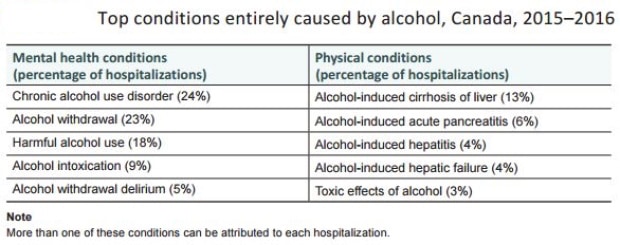
Pierre Trudeau brought in the automatic indexation of alcohol duties in the 1980s, but came under pressure from alcohol industry groups to drop the legislation. In the period since it was ditched, alcohol excise tax rates fell in real terms by approximately 45%.
According to the Public Accounts of Canada, the federal government collected about $1.6 billion (CAD) in excise revenue duties on alcohol in the last fiscal year.
Wales: Alcohol pricing is a legislative priority
Minimum unit pricing is one of the five Bills of new government (27 June)
The Welsh Government will introduce legislation that will make it illegal for alcohol to be sold below a set price.
Evidence shows a direct link between drinking harmful levels and the availability of cheap alcohol. As one of the government’s five Bills, the Public Health (Minimum Price for Alcohol) Bill will propose a formula for calculating the minimum price for alcohol, based on its strength and volume, and enable local authorities to enforce the powers and bring prosecutions.
The minimum pricing plans are expected to be policed by local councils, if implemented.
In his statement, First Minister Carwyn Jones sounded a bullish tone about his intentions for the legislative programme. He said: “The Bills we intend to introduce during the second year of this Assembly [including tackling harmful alcohol consumption] will support our efforts to build a Wales that is healthy and active, prosperous and secure, ambitious and learning and united and connected.”
Former Deputy Minister for Health Vaughan Gething sought to introduce a minimum unit price of 50 pence per unit in the previous government, arguing that it would be worth almost £900m to the Welsh economy in terms of reductions in illness, crime and workplace absence over 20 years, would lead to 50 fewer deaths a year, help prevent 1,400 hospital admissions, and would lead to an estimated 3,684 fewer offences a year.
But UK ministers denied the previous administration the chance to control alcohol law, maintaining instead that it should remain reserved to Westminster as it is closely linked to policing, both of which are controlled by the Home Office.
The proposal also depends on the result of a Supreme Court challenge against minimum unit pricing by the Scottish Government, to be announced later this year.
In response to the announcement, Professor Sir Ian Gilmore, chair of the Alcohol Health Alliance UK (AHA), said: “We welcome the Welsh government’s announcement today that it will introduce legislation to set a minimum price for alcohol.
“The cheaper alcohol is, the more alcohol-related harm is done, and at present there is a proliferation of cheap alcohol across the UK. Raising the price of the cheapest alcohol by setting a price below which it cannot be sold will save lives, reduce hospital admissions and cut crime.
“With Scotland also set to introduce minimum unit pricing, it is vital that the UK government now legislates for minimum unit pricing for England too, something it committed to doing five years ago but failed to follow through. With lives being lost as a direct result of freely available cheap alcohol, a decision to delay further will be in effect a death sentence for some of the most vulnerable in society.”
ALCOHOL SNAPSHOT: The effect of a 50p minimum unit price has been eroded, but only slightly
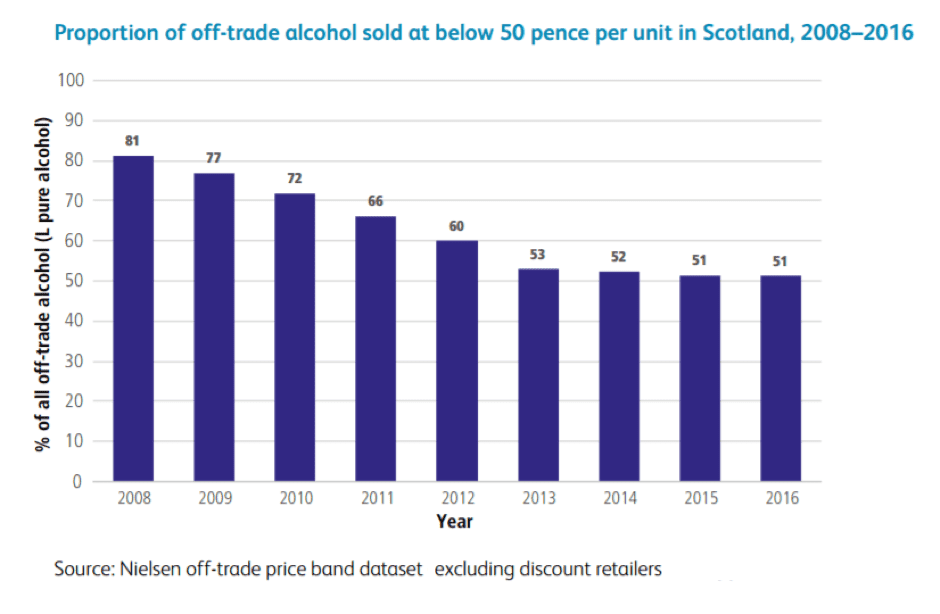
Five years have now passed since the Scottish Government legislated for a 50p minimum unit price for alcohol (MUP), without the policy yet having come into force. One possible concern after such a long delay is that the effect of the policy might have been eroded by inflation. In general, 50p buys you less today than it did in 2012, and so it is possible that inflation-linked price increases may have carried a number of cheap alcoholic products over the 50p threshold, and so beyond the scope of the MUP.
The chart above, from NHS Health Scotland’s Monitoring and Evaluating Scotland’s Alcohol Strategy (MESAS) Monitoring Report 2017, suggests this has occurred to a lesser extent than might have been expected. It shows that there was a substantial fall in the proportion of off-trade alcohol sold below 50p per unit between 2012 and 2013 (from 60 to 53%). Since 2013, however, there has been little change, and as of 2016, 51% of sales through the off-trade would be affected by a 50p MUP.
It is interesting to speculate on why this trend has stalled in this way. Historically low inflation is likely to have played a significant role – the average annual increase in the consumer prices index was 3.2% between 2009 and 2012, but only 1.2% between 2013 and 2016. The alcohol duty escalator, which ensured that tax on alcohol rose above inflation was scrapped in 2013 for beer and 2014 for wine, cider spirits. Producers’ and retailers’ pricing strategies are clearly important, too – and may have been influenced by the MUP legislation and the delays to its implementation.
The ultimate conclusion, though, appears to be that cheap alcohol is as prevalent as ever, and consequently, MUP remains as relevant as it was in 2012.
Podcast
Our monthly podcast features interviews with experts from across the sector.
Gambling industry harms and parallels with the alcohol world
Will Prochaska –
Coalition to End Gambling Ads

